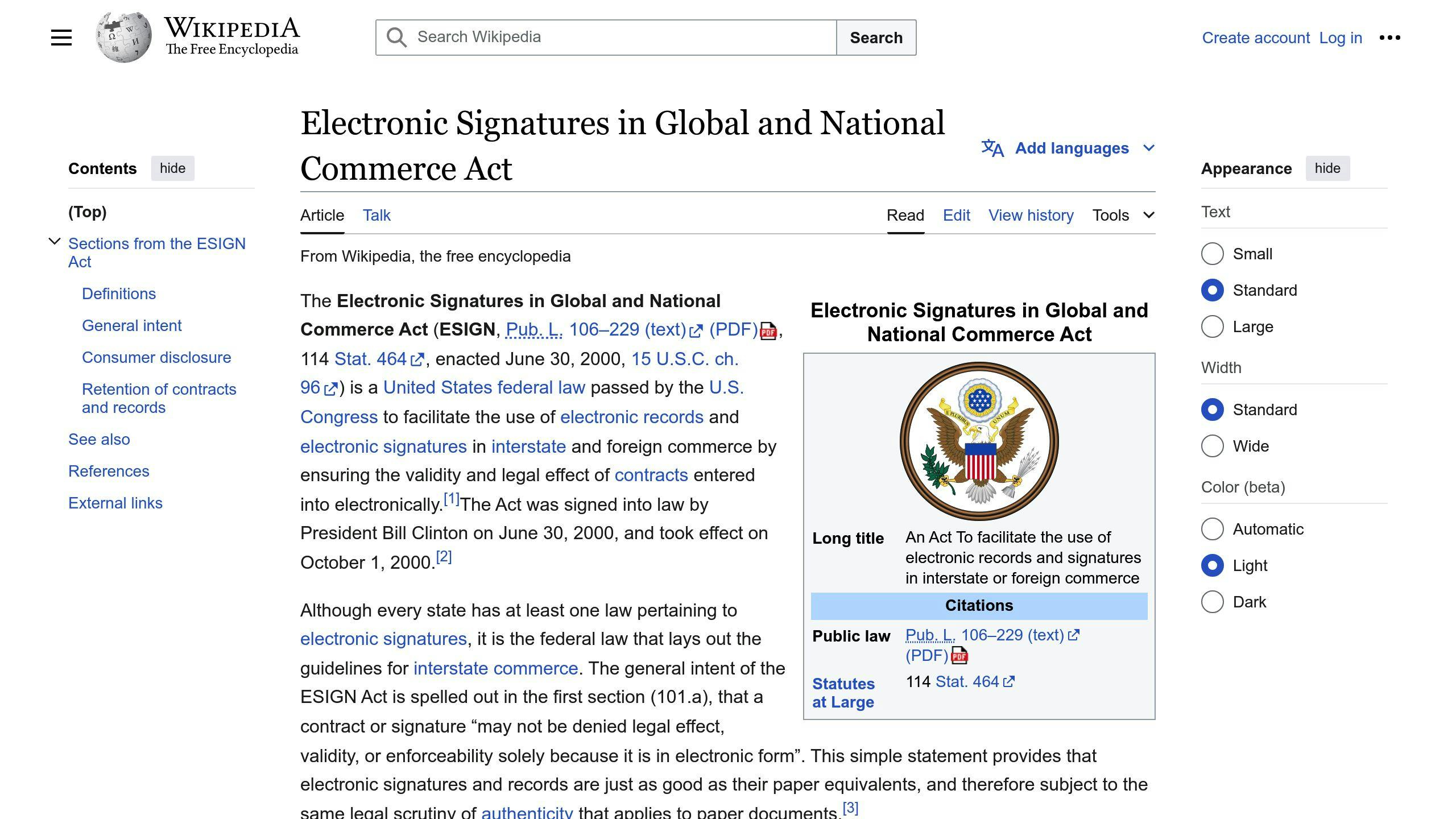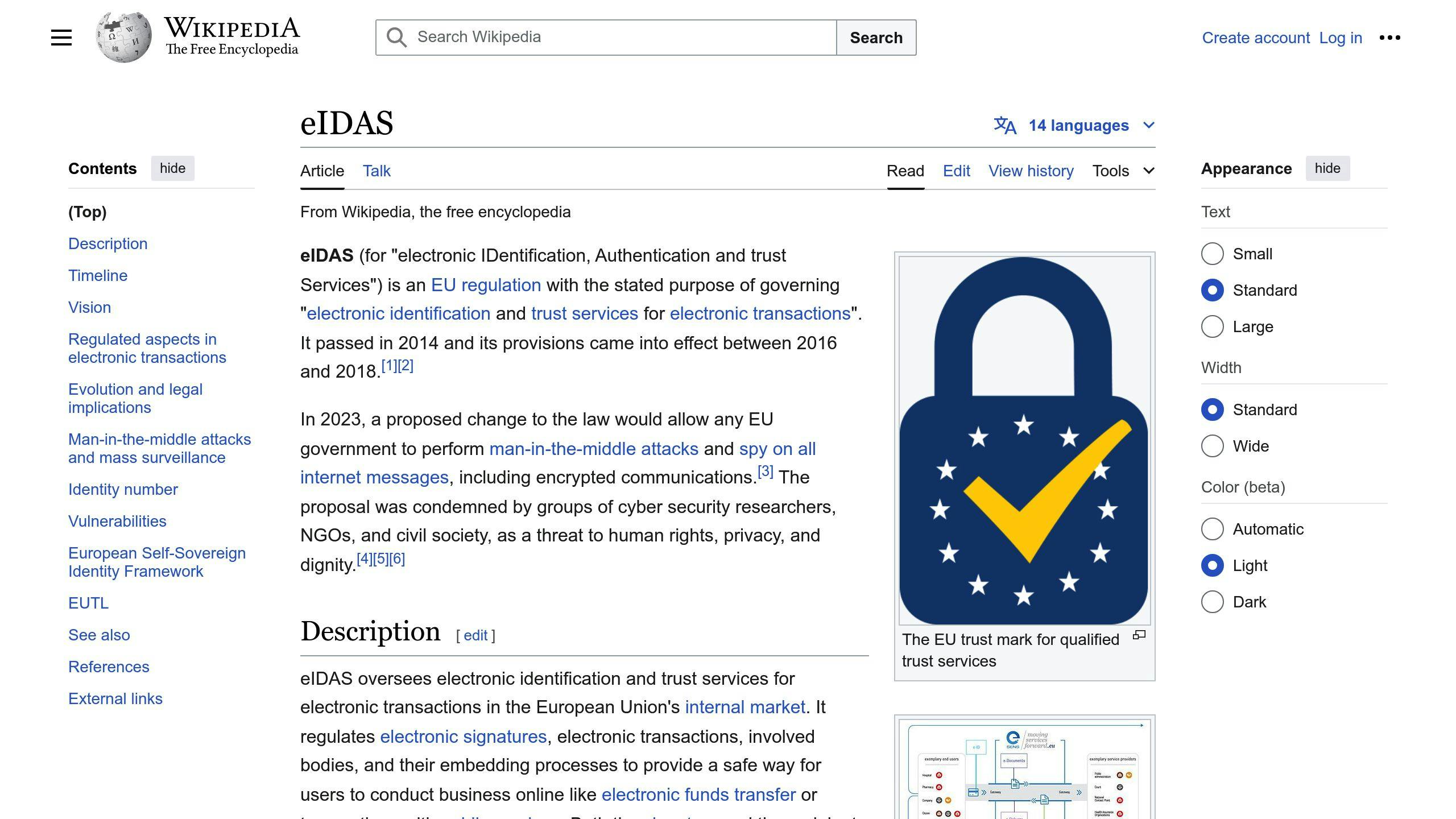E-Signatures for Legal Documents: Complete Guide 2024
Learn about e-signatures for legal documents, including types, laws, requirements, safety measures, and future trends. Find out how e-signatures are used in contracts, patents, real estate, and court papers.
Save 90% on your legal bills

E-signatures are digital ways to sign documents online, offering safety, speed, and legal standing. Here's what you need to know:
- Types: Simple (SES), Advanced (AdES), and Qualified (QES)
- Key laws: ESIGN Act and UETA (US), eIDAS (EU)
- Legal requirements: Intent to sign, consent, record-keeping
- Safety measures: Encryption, access control, audit trails
| Feature | SES | AdES | QES |
|---|---|---|---|
| Security | Basic | Better | Highest |
| Legal weight | Low | Medium | Same as handwritten |
| Cost | Often free | Moderate | Highest |
| Use case | Less important docs | Office papers | Big contracts |
E-signatures are used in contracts, corporate documents, patents, real estate, and some court papers. Challenges include varying laws and documents that still need pen signatures. Future trends include blockchain, biometrics, and AI integration.
Related video from YouTube
Types of E-Signatures
Simple, Advanced, and Qualified E-Signatures
There are three main types of e-signatures:
1. Simple E-Signatures (SES)
- Basic and easy to use
- Little to no checking of who's signing
- Good for less important papers
- Often free or cheap
2. Advanced E-Signatures (AdES)
- Linked to one person
- Better at checking who's signing
- Good for office papers and non-binding deals
- Cost more than SES
3. Qualified E-Signatures (QES)
- Highest safety and legal standing
- Checked by a third party
- Same as handwritten signatures in law
- Best for big deals like contracts
E-Signatures vs. Digital Signatures
People often mix up e-signatures and digital signatures, but they're different:
| E-Signatures | Digital Signatures |
|---|---|
| Any type of electronic signature | Special e-signature with extra safety |
| Can be as simple as typing a name | Need special codes and computer systems |
| Different levels of safety (SES, AdES, QES) | Always very safe and good at proving who signed |
| Legal standing depends on type and place | Usually seen as very safe and legal |
What Makes an E-Signature Legal
For an e-signature to count in law, it usually needs:
- Want to sign: The person must clearly want to sign
- Say yes: Agree to do business online
- Linked: The signature must go with the right paper
- Who signed: Must show who signed it
- Keep a copy: Must save the signed paper so you can find it later
In the U.S., the ESIGN Act and UETA make e-signatures legal. In Europe, the eIDAS rules do the same. These laws make sure e-signatures work in different places.
E-Signature Laws Around the World
Global E-Signature Rules
Many countries have laws about e-signatures. These laws make sure e-signatures work like regular signatures if they meet certain rules.
US Laws: ESIGN Act and UETA

The US has two main laws for e-signatures:
1. ESIGN Act
- Started in 2000
- Makes e-signatures legal
- Works for business and government
- Doesn't cover wills or family law
2. UETA
- Used in 49 states and DC
- Makes e-signatures legal
- Works for business and government
- Doesn't cover wills or family law
Both laws say e-signatures are as good as pen signatures in most cases.
EU Laws: eIDAS Regulation

The EU uses the eIDAS Regulation for e-signatures:
- Started in 2014
- Has 3 types of e-signatures
- Makes rules the same in all EU countries
- Sets rules for trusted e-signature services
The 3 types of EU e-signatures are:
- Simple Electronic Signatures (SES)
- Advanced Electronic Signatures (AdES)
- Qualified Electronic Signatures (QES)
QES are the strongest and work like pen signatures in all EU countries.
E-Signature Laws in Other Countries
Other countries have their own e-signature laws:
| Country | Law Name |
|---|---|
| Australia | Electronic Transactions Act 1999 |
| United Kingdom | Electronic Communications Act 2000 |
| Canada | Personal Information Protection and Electronic Documents Act |
These laws say e-signatures are okay, but the rules might be different in each place.
When doing business in other countries, it's important to know their e-signature laws to make sure everything is legal.
Legal Requirements for E-Signatures
To make sure e-signatures are legal, you need to follow some rules. These rules come from laws like the E-Sign Act.
Showing You Want to Sign
For an e-signature to work, it must show that you really want to sign. You can do this by:
- Clicking a "sign" button
- Typing your name
- Drawing your signature with a mouse
- Using your finger on a touchscreen
The main thing is to show you agree with what's in the document.
Asking Permission to Use E-Signatures
Before using e-signatures, you must ask everyone if it's okay. This means:
- Telling people they can get a paper copy
- Explaining how to stop using e-signatures
- Saying what the e-signature is for
- Showing how to change contact info
Connecting Signatures to Documents
E-signatures must be safely linked to the document. This usually means:
- Using special codes to lock the signature to the document
- Making it hard to change the document after signing
- Keeping a record of who signed and when
These steps make it hard to say the signature isn't real.
Keeping Signed Papers
It's important to keep good records of signed documents:
| What to Do | Why It's Important |
|---|---|
| Keep documents easy to find | So people who need them can see them |
| Keep documents for a long time | As long as the law says you should |
| Make sure records are correct | They should match the original document |
| Be able to make copies | In case you need to show them later |
For some documents, like house loans, you need to keep one main copy that can't be changed.
Checking and Protecting Signatures
To make sure e-signatures are safe:
1. Use good ways to check who's signing:
- Check emails
- Check work IDs
- Use passwords
- Send codes to phones
2. Make it hard to change documents:
- Use special codes
- Use strong computer protection
3. Keep track of everything:
- Write down computer addresses
- Note when things happen
- Keep a list of all steps in signing
Using E-Signatures in Legal Work
E-signatures help lawyers work faster and better. This part shows how to use them well in legal jobs.
Picking the Right E-Signature Tool
When choosing e-signature software, look for:
| Feature | Why It's Important |
|---|---|
| Good Safety | Keeps documents safe |
| Easy to Use | Makes work simpler for everyone |
| Works with Other Tools | Fits with the tools you already use |
| Follows Rules | Meets legal standards |
| Can Grow | Works for small and big jobs |
Adding E-Signatures to Current Systems
To make e-signatures work with your current tools:
- Connect e-signature software to your case system
- Set up automatic signing at the right times
- Keep all signed papers in one place
Tools like RunSensible can help with this.
Tips for E-Signature Processes
To get the most from e-signatures:
- Use strong safety measures when sending and keeping documents
- Keep your e-signature software up to date
- Control who can see and use documents
- Keep track of who does what with documents
- Let clients choose between e-signatures and pen signatures
Teaching Staff and Clients About E-Signatures
Help everyone learn about e-signatures:
| For Staff | For Clients |
|---|---|
| Train them on how to use the software | Show them how to sign |
| Explain the legal side of e-signatures | Give them easy guides |
| Be ready to answer questions | Explain why e-signatures are good |
| Show them how it makes work easier | Tell them how it keeps their info safe |
sbb-itb-ea3f94f
Safety and Rule-Following
This part explains how to keep e-signatures safe and follow the rules when using them for legal papers.
Keeping E-Signatures Safe
To make sure e-signatures are safe:
| Safety Step | What It Does |
|---|---|
| Use good codes | Stops others from seeing the papers |
| Control who can see papers | Keeps papers safe |
| Update the e-signature tool | Fixes problems that could let others in |
| Use two ways to check who's signing | Makes sure the right person is signing |
Tracking Changes and Stopping Cheating
It's important to keep track of what happens when people sign:
- Use an e-signature tool that writes down everything
- Keep a record of:
- When people sign
- What computer they used
- Their name and email
- Any changes made to the paper
These records help if there are problems later.
Following the Rules
You need to follow the rules when using e-signatures:
- Know the laws about e-signatures in your area
- Make sure your e-signature tool follows these laws
- Check your e-signature steps often to make sure they still follow the rules
Making E-Signatures Safer
To make e-signatures safer:
1. Use Good Ways to Check Who's Signing
- Check emails
- Use more than one way to make sure it's the right person
2. Teach People How to Use E-Signatures
- Show workers how to use e-signatures the right way
- Give clear steps to people signing papers
3. Check Your System Often
- Look at your e-signature system to make sure it's working right
- Fix any problems quickly
4. Keep Extra Copies
- Save copies of signed papers in a safe place
- Know how to get papers back if something goes wrong
E-Signatures in Different Legal Areas
E-signatures are now used in many parts of legal work. Here's how they help in different areas:
E-Signatures in Contracts
E-signatures make contracts easier to handle:
| Benefit | How It Helps |
|---|---|
| Faster | Sign from anywhere, no waiting |
| Cheaper | No need to print or mail papers |
| Better tracking | See who signed and when |
To make sure e-signed contracts work, add words that say e-signatures are okay to use.
E-Signatures for Company Documents
Companies use e-signatures for many papers:
- Company filings
- Worker agreements
- Board decisions
E-Signatures for Patents and Copyrights
The U.S. Patent and Trademark Office (USPTO) now lets people use e-signatures:
- Started on March 22, 2024
- Use "S-Signature" by putting your name between slashes like this: "/John Smith/"
| Document | Can Use E-Signature? | How to Sign |
|---|---|---|
| Patent Forms | Yes | S-Signature |
| Inventor Papers | Yes | S-Signature |
| Power of Attorney | Yes | S-Signature |
E-Signatures in Property Sales
E-signatures help when buying or selling property:
- Sign papers faster
- Sign from anywhere
- Good for deals with many people
But watch out for:
- Some real estate agents might not know all the details
- Mistakes can happen easily
- Some places might not accept e-signed property papers
E-Signatures in Court Papers
Courts are starting to accept e-signatures:
- Many courts say e-signatures are okay
- You can use them for:
- Rent agreements
- Court files
- Business deals
- Buying things
To make sure e-signatures work in court:
- Check what the court says about e-signatures
- Be ready to say it's your signature if asked
- Keep records of all e-signed papers
Problems with E-Signatures
E-signatures are helpful, but they can cause some issues. Here are the main problems legal teams should know about when using e-signatures.
Different Laws in Different Places
E-signature laws are not the same everywhere. This can be tricky for businesses working in many countries:
| Place | Main Law | Things to Know |
|---|---|---|
| United States | ESIGN Act, UETA | Most states use UETA, but Illinois, New York, and Washington have their own rules |
| European Union | eIDAS Regulation | Makes e-signature rules the same for all EU countries |
| Other Countries | Local laws | Businesses need to check the rules for each country |
To follow the rules:
- Ask lawyers who know about e-signature laws in different places
- Use the strictest rules when working in many countries
- Keep up with new rules and change how you work if needed
Documents That Can't Use E-Signatures
Some papers still need regular signatures with a pen:
| Type of Document | Why It Needs a Pen Signature |
|---|---|
| Court papers | Like summons, complaints, and family law papers |
| Wills and trusts | And papers that change them (with some exceptions) |
| Notices about health, safety, or where you live | Like eviction notices or stopping utilities |
| House and land deeds | Often need pen signatures, but other related papers might use e-signatures |
The rules for wills are changing:
- As of January 2024, six states and Washington D.C. let people use e-signatures for wills
- Six more states have their own rules about e-signatures for wills
- More changes are coming, so it's best to ask a lawyer for the latest info
Dealing with E-Signature Problems
E-signatures can cause some issues in court:
- People might say they didn't sign
- It can be hard to prove e-signatures are real in court
- Companies might say the person who signed didn't have the right to do so
To help avoid these problems:
- Put words in contracts saying e-signatures are okay to use
- Keep good records of who signed what and when
- Be ready to show that e-signatures are real if there's a problem
- Think about using pen signatures for very important papers
What's Next for E-Signatures
E-signatures are changing fast. Here's what we might see in the future:
Blockchain and Smart Contracts
Blockchain can make e-signatures safer:
| Feature | How It Helps |
|---|---|
| Better Safety | Makes a record that can't be changed |
| Smart Contracts | Papers that work on their own |
| Following Rules | Shows clearly who signed and when |
Using Body Features to Sign
Signing with body features like fingerprints is getting more common:
- Checks who you are better
- Lets you sign from far away
- Stops people from faking signatures
AI in Checking E-Signatures
AI can help with e-signatures:
| AI Use | What It Does |
|---|---|
| Finds Mistakes | Spots problems in signatures |
| Checks Signatures | Makes sure signatures match |
| Checks Who's Signing | Uses face checking or ID papers |
E-Signatures Across Countries
E-signatures are getting easier to use around the world:
- Same rules in different countries
- Use from any computer or phone
- Easy to sign on phones
As e-signatures change, businesses that keep up will do better in a world where more work is done online.
Wrap-Up
E-signatures have changed how we handle legal papers, making things faster, safer, and easier. As we look ahead, e-signatures will keep getting better, with new ideas and more people using them.
New computer tools like blockchain and AI are making e-signatures even safer:
| Technology | How It Helps |
|---|---|
| Blockchain | Makes records that can't be changed |
| AI | Checks signatures better and spots fake ones |
As laws catch up, e-signatures will work better around the world. This means:
- Easier to do business across countries
- Different e-signature systems working together better
- More people using e-signatures on phones and computers
For lawyers and businesses, it's important to keep up with these changes. Using e-signatures can:
- Make work faster
- Save money
- Help clients better in a digital world
But it's also key to:
- Follow the rules
- Keep things safe
- Make sure e-signatures meet legal needs
The trick is to balance new ideas with safety, and ease of use with following the law. By doing this, legal teams can use e-signatures to:
- Work better
- Spend less
- Make clients happier
As we move forward, e-signatures will become a bigger part of how we do legal work in the digital age.
FAQs
What makes an e-signature legal?
For an e-signature to be legal under the ESIGN Act, it needs:
| Requirement | Description |
|---|---|
| Intent to sign | Clear show of wanting to sign |
| Consent | Agree to do business online |
| Opt-out option | Way to stop using e-signatures |
| Signed copies | Ability to get copies of signed papers |
| Record keeping | Saving signed papers for later |
These steps make sure e-signing is clear, agreed upon, and well-recorded.
What are the main rules for e-signatures?
E-signatures are okay when:
- Both people clearly want to sign
- Signers type their name, click "Accept", or draw their signature
- The process is clear and agreed upon
- The signature links directly to the person signing
When is an e-signature legally binding?
An e-signature counts in law when:
| Condition | Explanation |
|---|---|
| Clear document | The paper and its parts are easy to understand |
| Clear intent | The person clearly wants to sign |
| Follows laws | The signing follows rules like ESIGN Act or eIDAS |
| Keeps records | There's a way to check who signed and when |
| Links to signer | The signature can be traced back to the person |
These rules help make sure e-signatures work like regular signatures in legal matters.







